ADORA
ADORA is the premier Environmental and Safety offsite Consequence Analysis tool available for use by organizations involved with environmental impact assessments for intentional or accidental discharge of hazardous chemicals that react with air, moisture or each other.
ADORA models:
- OBOD (Open Burn and Open Detonation) of munitions and waste.
- Spills of chemicals that react with moisture (e.g., halogenated compounds and silanes).
- Fire and Explosion of chemical mixtures in accidents involving chemical warehouses, tank farms, and rail cars.
- Nuclear, Biological and Chemical (NBC) releases.
With its 2100+ chemical database (phases included), ADORA:
- Has been validated against available test data
- Is listed by the EPA
- Was selected for use in Toxic Release Inventory reporting at 13 ammunition depots of the United States Army
- Is a standard emission and air dispersion model for the MNMI Environmental Team at Eglin Air Force Base (for which it was originally developed)
The uniqueness of ADORA lies in the way the chemical reactions and complex thermodynamic transformation of the released chemicals are treated. The source characterization for various release scenarios, reacting puff spreading, lift-off and rise, and transient dispersion under practical meteorological conditions are modeled based on engineering principles. The complex interactions of buoyant/heavy cloud turbulent dynamics, multi-phase thermodynamics, and multi-step chemical reactions for various pollutants are included. The accurate treatment of these processes allows the application of the model to realistic release scenarios without being too conservative.
Hazard distances predicted by ADORA are often times shorter than those predicted by other models since the model accounts for the following:
- Heat released from chemical reactions increases cloud buoyancy
- Transient buoyant cloud has higher final rise height
- Heat released from chemical reactions accelerates the cloud dilution rate
- Chemical reaction may reduce cloud toxicity over time
Applications
Applicable Regulations
Model Capabilities
ADORA Advantage for RMP
Validation
Applications
ADORA can be used in air quality assessments for releases involving single or multiple chemicals. Examples include conflagrations involving chemical warehouses, rail cars, or tank fires, explosions, pool fires, forest fires, petroleum product burns, open bun/open detonation applications, and spills of chemicals that react with atmospheric moisture.
Three types of release scenarios can be modeled using ADORA:
- ADORA for Demilitarization Program: Open Burn Open Detonation (OBOD) is a common means of disposing conventional weapons and wastes containing energetic materials (such as explosives). ADORA can be used to predict the type and amounts of various chemicals formed due to OBOD operations, their dispersion in the atmosphere and deposition on ground.
- ADORA for Off-site Consequence Analysis Program: ADORA can model continuous releases (eg., accidental spills) of chemicals that may react with atmospheric moisture. Such chemicals (e.g., boron trichloride) may be initially heavier than air, but become buoyant due to the exothermic reactions with ambient moisture. This model can be applied to the Environmental Protection Agency’s (EPA) Off-site Consequence Analysis (OCA) for Risk Management Planning (RMP) for chemical process industries.
- ADORAnuclear:Uranium Hexafluoride (UF6) is a commonly used fuel in nuclear enrichment plants. When released into atmosphere, UF6 reacts with ambient humidity to form hazardous compounds such as hydrogen fluoride. Hydrogen fluoride, in turn, undergoes a number of thermodynamic transformations (polymerization and condensation with water). ADORAnuclear solves the simultaneous chemical reactions, thermodynamic transformations, and cloud motion to determine the evolution and spread of the cloud formed from different types of UF6 releases into atmosphere. The model can predict the hazard areas affected due to UF6 releases, dosage of UF6 and HF and deposition of small solid aerosol particles formed from reactions. The predictions of the model are realistic and compared well with some of the accidents that occurred in UF6 processing plants over the years.
- ADORA for Preparedness against Terrorist Attacks:In the aftermath of September 11, 2001, terrorist attacks on industrial complexes, chemical and biological agent storage facilities has become a major concern. ADORA models teh accidental or intentional release of toxic emission from these facilities.
Applicable Regulations
TThere are three important regulations in the environmental safety area that provide the main thrust for the commercialization of ADORA. These are:
- Risk Management Plan (RMP), Clean Air Act Amendment 112 (r): For Alternate Scenarios in RMP, ADORA accurately predicts atmospheric dispersion of buoyant and moisture-reactive chemicals. Clients can take credit for a reduced hazard at ground due to the cloud rise resulting from buoyancy or exothermic reactions. For the general duty clause, ADORA evaluates potential conflagrations from releases of multiple chemicals.
- The Occupational Safety and Health Act (OSHA): Process Safety Management – similar to 112 (r) except that OSHA is mainly concerned with the in-plant hazards.
- The Resource Conservation and Recovery Act (RCRA): Parts B and X -- ADORA has been used in a number of environmental permitting applications.
Model Capabilities
- Dispersion of heavy/buoyant/neutral materials
- Thermodynamic behavior including solid/liquid/vapor phases and their changes
- Time-dependent entrainment of surrounding air
- Complex exothermic chemical reactions and thermal radiation
- Instantaneous reacting and non-reacting release
- Continuous non-reacting release
- Accounting for fireball and ground attached tail partitioning
- Proprietary algorithm for approximation of kinetic mechanisms
- Source specifications and near-source effects
- Environmental hazard assessment in terms of concentrations and dosage
- Automated identification of the worst-case scenario
ADORA has a database of over 2100 chemicals and species and can be used to model the release of any combination of these chemicals together. ADORA runs on IBM PC compatible computers with Windows 95/NT operating systems. Combined with powerful plotting capabilities and a Graphical User Interface (GUI) for ease of use, ADORA has all the necessary requirements to be an effective environmental tool. ADORA has been validated and is listed by the EPA. Interested users can either buy a service (we run it for you) or the software license.
ADORA Advantage for RMP
ADORA is the only software that couples air dispersion with chemical reactions and heat release. This coupling is critical to realistic modeling of potential hazards. Such predictions often result in reduced hazard distances compared to the other models which introduce unnecessary conservatism by not accounting for the physics accurately. ADORA:
- Lowers the cost of risk management
- Facilitates the approval of site permitting
Cloud Lift-off Due to Chemical Reactions with Moisture
Halogenated inorganic chemicals such as boron trichloride and titanium tetrachloride have a strong tendency to react with moisture. Other models neglect such reactions and therefore predict unrealistic hazard distances. ADORA, on the other hand, accounts for such chemical reactions with the entrained moisture during atmospheric dispersion.
Boron trichloride is initially heavier than air at ambient temperatures. In the absence of chemical reactions with ambient moisture, the BCl3 cloud hugs the ground over large distances. Chemical reactions with moisture result in the formation of hydrogen chloride (HCl) and the heat released due to chemical reactions lifts the cloud off the ground reducing the ground level hazard.
(a) No reaction: Contour of Reactant BCl3
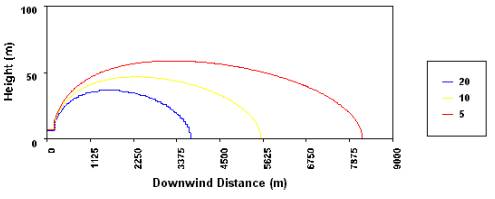
(b) With reaction: Contour of Reactant HCl
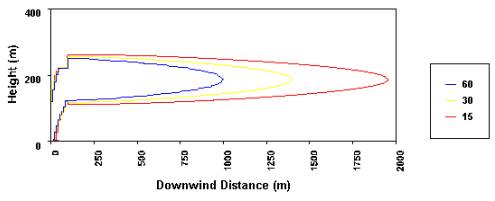
Concentration contours (mg/m3) for BCl3 releases
The following table shows the effect of accounting for chemical reactions with ambient moisture for four chemicals.
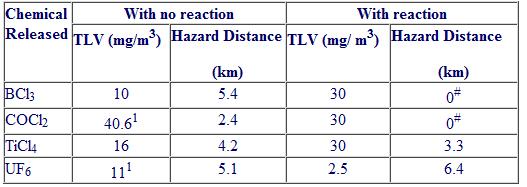
1. Reactant equivalent TLV calculated based on the product TLV.
2. Downwind hazard distances are computed at ground-level.
# Cloud lifts off
In summary, ADORA solves for the exothermic reactions between the released chemical and ambient moisture for the release of moisture-reactive chemicals. If the heat release from the reaction is significant enough, it predicts the lift-off of the initially dense ground-hovering clouds
Validation
Validation is a crucial step in any model development. Over the years, numerous national programs conducted tests and collected data for the validation of source characterization and atmospheric dispersion models. We validated various modules of ADORA using some of these data:
Dense Gas Dispersion
In this test, 3100 to 4200kg of Freon/Nitrogen mixtures were released instantaneously. A comparison of the test data with ADORA predictions shown in the figure below shows excellent agreement.
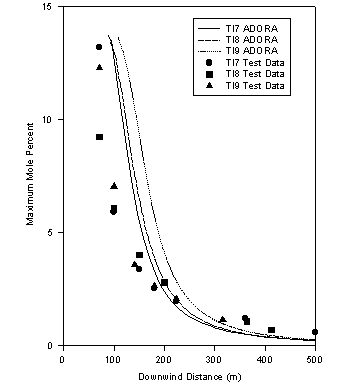
Predicted vs. Measured Concentrations from a release of Freon/Nitrogen mixture.
(Source: Test Data form Thorney Island: McQuaid J. (1985) ed., Heavy Gas Dispersion Trials at Thorney Island, Elsevier, xii, 435p)
Thermodynamics
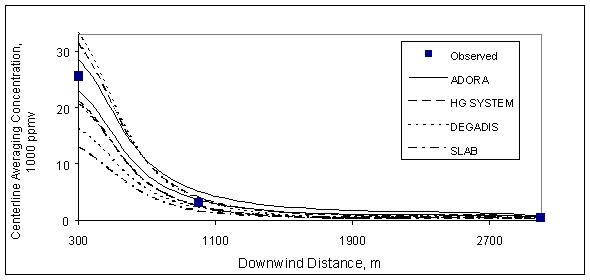
Comparison of ADORA and other models with experimental observations for a spill of anhydrous hydrogen fluoride.
Under normal conditions, HF is heavier than air. When HF stored under normal ambient conditions is released into the atmosphere, it slumps to the ground. Subsequently, HF disperses as a ground-based cloud. A spill of HF was modeled by ADORA and the other models. In this figure the calculations are compared with the experimentally measured cloud concentrations. Again, the ADORA predictions match the experimental results very closely. For this case, the experimental concentrations are higher than SLAB and DEGADIS and much lower than HGSYSTEM predictions.
Fireball
Here our goal was to validate the physics modules of ADORA. We compared our predictions with the test data for ethane, a typical hydrocarbon. The calculations agree very well with test measurements over seven orders of magnitude in energy release.

Predicted vs. measured fireball diameters
Chemical Species
Comparison of emission factors computed by ADORA with other models and experimental observations.
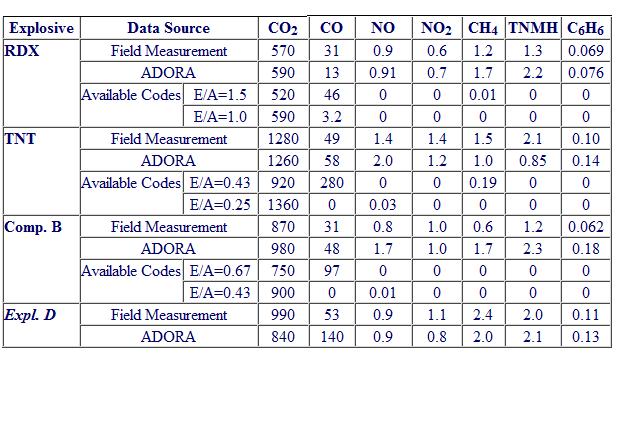
The emissions from OB/OD operations are usually expressed in terms of emission factors. An emission factor is defined as the mass of a species released into the atmosphere per unit mass of the explosive burned or detonated. In the above table the emission factors computed using ADORA and other codes are compared with field measurements. ADORA's predictions of emission factors are in close agreement with the test results from the Dugway Proving Ground study. The explosive/air mass ratio is calculated by ADORA while it has to be imprinted in the available equilibrium codes. Even when the E/A ratio is pre-assigned to match the CO2 measurement, the prediction of CO is not accurate and NOx and VOCs are completely off. In summary, ADORA provides more accurate and conservative results than the other codes.
